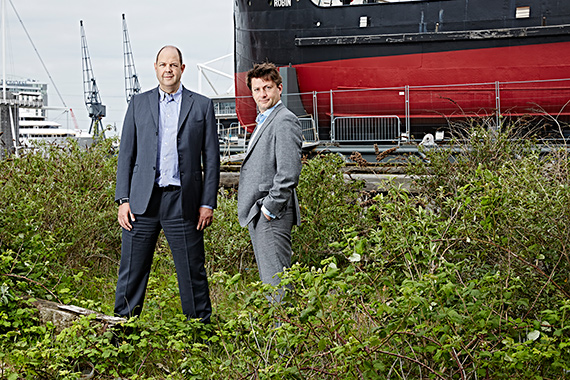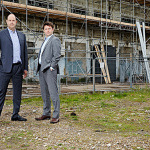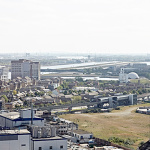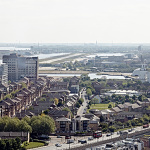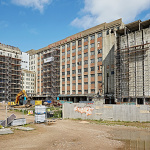How do you transform 62 acres of east London wasteland into a 7.7m sq ft mixed-use mecca? Emily Wright visits developer First Base on site at Silvertown Quays to find out. Photographs by Tom Campbell
“One day…” Elliot Lipton trails off, distracted as he sidesteps another huge tangle of weeds strewn with rubbish, chunks of masonry and an abandoned sleeping bag. Brambles successfully navigated, he starts again. “One day…this will be the new Soho.”
It would be a bold statement to make even if the managing director of developer First Base was not balanced on a patch of rocky terrain in London’s Royal Docks looking out across 62 acres of wasteland with nothing but a derelict, asbestos-riddled flour mill between him and the horizon.
But to dismiss the group’s ambitious vision for its £3.5bn Silvertown Quays E16 scheme – a vision that received planning just over a month ago – would be short-sighted. Wasteland or not, 62 acres is still 62 acres in a city with a dearth of land and a chronic housing shortage. And that asbestos-riddled flour mill happens to be a 500,000 sq ft Art Deco cultural icon which, once restored, will set the tone for the entire development. Add to this the fact that the site is 10 minutes from City Airport and will be just 14 from the West End once the Custom House Crossrail station opens in 2018, and the foundations for First Base’s bullish confidence in the project start to crystallise.
Bullish remains the operative word, though. A well-connected scheme in the heart of the capital’s fast-growing eastern fringe is one thing. Whether it will meet First Base’s goal of becoming “London’s new creative capital” is another. Setting out to rival Soho means there is a long way to fall if the vision comes up short. But Lipton and First Base’s director Barry Jessup are convinced Silvertown has what it takes.
Here they set out how they will deliver their east London ambitions and reveal the group’s wider portfolio as it prepares to venture out of London for the first time.
Silvertown: the beginnings
The Silvertown regeneration story started back in June 2013 when the Silvertown Partnership – comprised of First Base, developer Chelsfield, and investment bank Macquarie Capital – was appointed by the GLA to redevelop the site and create an innovation quarter.
Since then the man behind Chelsfield, Lipton’s father Sir Stuart, has moved on to set up developer Lipton Rogers with former Stanhope boss Peter Rogers. But he remains heavily involved with the Silvertown project. And working so closely with his father – particularly as First Base has become better known as a mixed-use developer on projects anchored by residential than as a pure housing specialist – is something Lipton junior is happy to speak candidly about: “Initially I was worried about having two strong personalities working on the same project,” he says. “But we have both had clear areas to focus on and there have been no issues.”
Two years on from the consortium’s appointment and just over a month after receiving planning for the project, investment is high on the list of priorities. “Macquarie will be looking to raise funds for the first phase of the project, which will be a 1.8m sq ft premises, in the next few weeks,” says Jessup.
That equates to a fraction of the 7m sq ft project which, over the course of the next decade, will require billions of pounds of investment and will eventually deliver up to 3,000 homes, 2m sq ft of commercial space and 3m sq ft of brand space.
The latter element is a nod to some of the more original features in the plans. This will be the first scheme of its kind to incorporate brand pavilions – spaces where retailers and brands will advertise and raise awareness through experiences, exhibitions and a physical presence on site but will not actually use the premises to sell products.
“It is not a new concept,” says Jessup. “But it is the first time pavilions have been included in a new, mixed-use development like this.”
But why? “We wanted to deliver something that reflected the different ways brands are using space,” adds Lipton. “Brands are looking for space to showcase who they are and what they are doing – even ones known for being primarily digital. And we wanted to make sure we were thinking ahead to what occupiers will be looking for in the future as well as what they want right now.”
Starbucks-free zone
If First Base has any hope of succeeding in its quest to create the new Soho, it will need more than a clutch of innovative pavilions. On a site this big, the right retail and leisure occupiers will need to descend in their droves.
At this stage names have not been announced but Lipton says that careful curation will be key and that there will be a deliberate focus away from chains in favour of trendy independents and start-ups. “We want this to be a new, 24-hour destination in London. Docks surround the site so it will also be a waterfront destination but we want the occupiers to reflect the area’s vibe as a creative hub. We are looking into new, young companies and some independent restaurants and bars. We don’t want the area to be populated by chains.”
So no Starbucks then? “No Starbucks,” laughs Lipton.
And on whether the occupiers First Base is targeting will want to move so far out of London’s centre, he has no concerns. “Crossrail is the game changer. It will put this site less than 15 minutes from the West End. History tells us that the property industry follows major infrastructure investment.
“And look at the area now. Knight Dragon is here, ABP is here, we are here. The level of development in this part of London is unbelievable. Plus, being out east, away from top rents in prime central London, means we will be able to offer better value for money.”
The jewel in the crown
If all of that is still not enough to attract the creative crowd, the redevelopment of the iconic Millennium Mills building – a story in its own right – just might do the trick. The crumbling structure is arguably the jewel in the Silvertown crown, thanks to its cult following and high profile. Voted one of the Guardian’s top 10 ruins of 2015, the mill has appeared in music videos for bands including the Arctic Monkeys, The Smiths and Snow Patrol.
Restoration works on the mill began in January this year, starting with an asbestos strip, following a £12m grant from the department for Communities and Local Government. And First Base hopes that the decision to turn this building into a start-up hub rather than use it for residential – “the easy option” – will draw cool, young companies to the area, lured by the chance to be based in a cultural icon. “Because of Millennium Mills, this area and site is on more people’s radars outside the property industry than it is within the sector,” says Jessup. “The fact that it is home to such an iconic building, one that has been used in films and music videos, means it is already well known in the artistic world. These are the people we are looking to attract.”
Looking outside London
Walking around the vast site it is easy to forget that this is not First Base’s only project.
The group has come a long way since it launched in 2002 with a focus on developing affordable housing in London. Not only has First Base grown to become known as a mixed-use residential developer but it is now looking outside London.
“We have always wanted to be ahead of the market,” says Jessup. “That has meant getting to locations before others, often in places where infrastructure will make a big change. We did that in Haggerston, E2, with Adelaide Wharf and in Elephant & Castle, SE1, with Printworks. Now we are looking at infrastructure and realising how much it opens up the South East.”
The group will be focusing on Brighton first, thanks to the transformation of the area around London’s Victoria station, SW1, to create a desirable business and leisure destination at the end of the Brighton line. The group is working with Conran + Partners on a £100m scheme in the heart of the South Coast city due to complete in 2017.
“As a developer with a London heritage, there are some areas we are more welcome than others,” adds Jessup. “But we are looking along the major new infrastructure routes, so Brighton, obviously, then Reading, Colchester, Chelmsford, Sevenoaks, Bromley, Guildford and Milton Keynes. We have a significant number of major investors who understand our logic and strategy here. The challenge is finding the right sites. We are looking for the second-best or best sites in each of these towns and cities.”
Confident of success
And does that high standard apply in London? Lipton and Jessup seem confident they have bagged one of the best sites in the city, particularly on this scale. But it will take more than the kudos of living and working near the set of an Arctic Monkeys video to create a district that rivals Soho. All eyes will now be on First Base to see if its delivery can live up to its ambitions.
• Hear more on the Royal Docks at LREF, 10-11 June www.lref.co.uk/conference2








